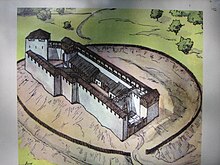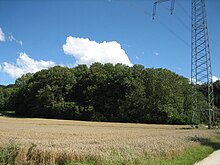Bürgle (Gundremmingen)
| Bürgle near Gundremmingen | |
|---|---|
| Alternative name | Pinianis |
| limes | Danube-Iller-Rhein-Limes , Raetia secunda , (route 5) |
| Dating (occupancy) | Late 3rd century to early 5th century AD |
| Type | late antique border fortifications |
| unit | cohors V Valeria Frygum |
| size | 0.16 ha |
| Construction | Stone and framework |
| place | Gundremmingen |
| Geographical location | 48 ° 30 '18.6 " N , 10 ° 24' 53.4" E |
| Previous | Guntia |
| Subsequently | Fort Burghöfe |
The Bürgle near Gundremmingen was a late antique fort in the Roman Danube-Iller-Rhein-Limes in the province of Raetia secunda in the area of today's Gundremmingen in the district of Günzburg an der Donau .
Location and history
Between the places Gundremmingen and Aislingen there is an embankment that separates a tertiary plateau from the swampy Donauried and in some cases has a height difference of 70 m compared to the Danube. A brook rises from the “Aschberg” corridor, which cut into the embankment and left behind an elongated crest that was popularly known as the Bürgle . Springs emerge on the north side of the Bürgle, which caused the surrounding plain to be swampy. Thus an approach was only possible over a ridge from the east.
In Roman times, the summit was 700 m southwest of the earlier vicus (settlement) on the Aschberg and 500 m away from the Roman Danube South Road. It drops down to ten meters on all sides, the ridge includes an area of 60 × 25 m.
The identification of the small complex with a fort named in the Notitia dignitatum is not completely certain. It is believed that the name of Faimingen (Phoebiana), north of the Danube, was transferred to the Bürgle.
The cohors V Valeria Frygum is thus documented as the crew . Compared to the cohorts of the middle imperial period, the unit is likely to have had a significantly lower nominal strength. Even the considerations of a fort crew of 150 men are likely to be exaggerated. Finds of horse harness, costume components and ceramics reveal Germanic federates as the occupation. Spinning whorls and loom weights at least suggest the intermittent presence of women.
The evaluation of the found coins shows a construction time towards the end of the 3rd century AD.
The Bürgle was destroyed by a fire in the late 4th century. Apparently the trenches were repaired shortly before, which suggests a connection with armed conflicts. The series of coins ends abruptly with eight quite freshly minted pieces, which were minted between 378 and 383 AD under Gratian , Valentinian II and Theodosius I in Aquileia .
exploration
Paul Reinecke succeeded in discovering the late antique fortification at the beginning of the 1920s. After funds were made available by the Roman-Germanic Commission , the chairman of the responsible historical association, university professor Paul Zenetti from Dillingen , undertook excavations in 1921/22 and 1925. However, the results were only made available after the Second World War in 1964 by Gerhard Bersu publishes.
Unfortunately, the western part of the Bürgle has been lost due to sand mining in modern times, just as all the stones were broken out for recycling. Nevertheless, Bersu and Zenetti succeeded in almost completely reconstructing the floor plan.
investment
The plan of the excavations shows a long rectangular camp with protruding towers in the northeast and in the west. The size is 28 × 65 m with a walled inner area of 0.16 hectares. The approximately three meter wide outer wall was partly founded with spolia from stone monuments from the Middle Imperial period, which come from Faimingen. The main gate was in the east. From there the camp road led along the longitudinal axis through the camp and ended in a small inner courtyard in the west. This was presumably dominated by a large, tower-like structure. Subsequently, a smaller hatch is assumed in the northwest.
The foot of the summit was surrounded by a ditch up to four meters wide, which was partly pointed, partly as a bottom ditch.
Interior development
There were crew quarters on both sides along the three to four meter wide camp road, which were built in timber or half-timbered construction. 18 hearths were detected in it. Only the presumed residential wing of the commandant in the west was made a little more comfortable. He owned a room with hypocaust heating and then several rooms with a screed floor ( opus signinum ) .

Monument protection
The fort is a registered ground monument within the meaning of the Bavarian Monument Protection Act (BayDSchG). Investigations and targeted collection of finds are subject to authorization, accidental finds must be reported to the monument authorities.
See also
literature
- Helmut Bender (ed.): The "Bürgle" near Gundremmingen. The 1971 excavation and new finds. Marie Leidorf, Espelkamp 1996, ISBN 978-3-89646-170-4 , ( Passauer Universitätsschriften zur Archäologie 3).
- Gerhard Bersu : The late Roman fortification "Bürgle near Gundremmingen". Beck, Munich 1964, ( Bavarian Academy of Sciences. Commission for the Archaeological Research of the Late Roman Raetia Publications 4), ( Munich contributions to prehistory and early history 10).
- Wolfgang Czysz : Bürgle, Gde. Gundremmingen, Lkr. Günzburg, Schw. In: Wolfgang Czysz among other things: The Romans in Bavaria. Theiss, Stuttgart 1995. Licensed edition Nikol, Hamburg 2005, ISBN 3-937872-11-6 , p. 430f.
- Jochen Garbsch : The late Roman Danube-Iller-Rhein-Limes . Society for Pre u. Early history in Württemberg and Hohenzollern eV, Stuttgart 1970 ( Small writings on the knowledge of the Roman occupation history of Southwest Germany 6).
- Paul Zenetti : The excavations on the Bürgle near Gundremmingen . In: Yearbook of the historical association Dillingen an der Donau . Volume 36, Dillingen 1923, pp. 65-73, online .
- Paul Zenetti: The excavations of the historical association Dillingen a. D. In: Yearbook of the historical association Dillingen an der Donau . Volume 37, Dillingen 1924, pp. 151-163, online .
- Paul Zenetti: The excavations of the historical association Dillingen 1925/26 . In: Yearbook of the historical association Dillingen an der Donau . Volume 38, Dillingen 1925, pp. 130-149, online .
- Paul Zenetti: The excavations of the late Roman fort on the Bürgle near Gundremmingen . In: Yearbook of the historical association Dillingen an der Donau . Volume 39/40, Dillingen 1926/27, pp. 245-264, online .
Web links
Individual evidence
- ↑ Occ. XXXV 29.
- ↑ a b Wolfgang Czysz : Bürgle, Gde. Gundremmingen, Lkr.Günzburg, Schw. In: W. Czysz u. a .: The Romans in Bavaria. Nikol, Hamburg 2005, ISBN 3-937872-11-6 , p. 430.
- ^ Hans-Christoph Noeske, David Wigg: The found coins of the Bürgle near Gundremmingen. in: H. Bender (Ed.): The "Bürgle" near Gundremmingen. The 1971 excavation and new finds. Espelkamp 1996 (Passauer Universitätsschriften zur Archäologie 3), pp. 49-102.



